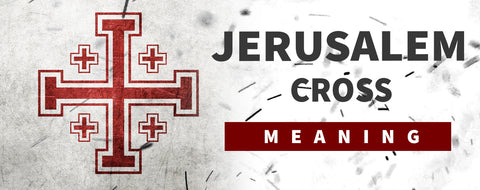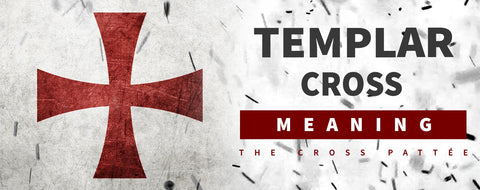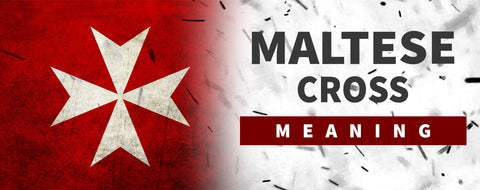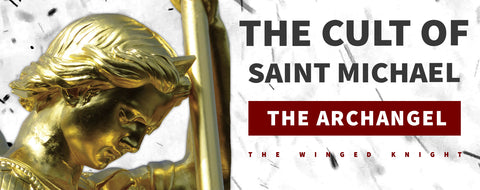
Teutonic Order : The Third Order
of reading - words
The Teutonic Order was founded in 1190. This Knight Order has an important 'Military and Religious' specificity and we will describe why in this blog article on the Teutonic Order and its origins. Why was this order created ? How does their structure work and how are they organized ? What was their role within the Order of the Knights Templar ? In any case, we are going to try to understand more deeply the incredible history of the Teutonic Order.

1) The Teutonic Order
A. Knights of The Teutonic Order and the Hospitallers
The Teutonic Knights (Deutsche Ritter) are the third great order of religious and military chivalry to emerge from the Crusades, the second being the Knights Templar Order, the first being the Order of St. John of Jerusalem (Hospitallers) founded in 1113. If the Knights Templars and the Teutonic Knights are unanimous among historians as to their "Military and Religious" specificity, it is not the same for the Hospitallers because their "Military" specificity remains to this day to be demonstrated even though they participated in the battles of Ascalon in 1154 and Saint John of Acre in 1151. The Knights Hospitallers should rather be qualified as a "Religious and Armed Hospitaller" Order. The Teutonic Knights (Deutsche Ritter) were originally Hospitallers dedicated to the relief of sick or wounded Crusaders. The Teutonic Order from an old word meaning German was founded by German knights in 1198 in the Holy Land. Its warrior monks were recognizable by their large white cloak decorated with a black cross.

The first members bore the title of Brothers of St. Mary. Reorganized into a military order in 1190 by Emperor Frederick of Swabia, the order had its headquarters in St. John of Acre. The new knights were subject to the rules of the Hospitallers for the duties of charity and to those of the Knights Templar for military discipline.
In 1226, he was recruited by the Polish Duke Conrad of Mazovia, whose lands had just been invaded by a still pagan people from the shores of the Baltic Sea, the "Pruzzen" or "Borussians.”
B. The Warrior-monks
The Warrior-monks carry out their mission with extreme brutality, exterminating rather than converting the Borussian populations and implanting German settlers who soon adopt the names of their predecessors. This is how the region took the name Prussia. This military colonization is part of the "Drang nach Osten.” However, the warrior monks suffer a first defeat on the ice of Lake Peïpous, on the border of present-day Estonia, against the army of the Russian prince Alexander Nevski. They will not try to push further German colonization.

C. The end of the Crusades
At the end of the Crusades, the order came to Europe where it acquired vast possessions in Germany, Italy, Hungary, Transylvania, and was placed among the European powers. From then on, its history was merged with that of Prussia and the countries bordering the south-eastern Baltic Sea. From the beginning of the 15th century its power began to fall apart. It ceased to exist de facto with the empire of Germany at the beginning of the 19th century. Napoleon had definitively suppressed it by a decree of 24 April 1809: the King of Prussia tried to relieve it in 1852 under the title of the Evangelical Order of St. John. Austria also instituted a Teutonic Order in 1840. However, from then on it was no longer a matter of honorary titles.
2) Organization and Structure of the Teutonic Order
A. The different roles of the Members of the Order
The Teutonic Order was one of the most powerful military organizations in Europe at the end of the Middle Ages. At that time it consisted of :
- Brother knights : they take the monastic vows of chastity, obedience, poverty and take an oath in addition to fighting the enemies of Christianity with weapons. They are therefore high level warriors, as well trained for both mounted and dismounted combat. The knight has full armor, two or three steeds and horses for travel and loading. The knight commands a garrison or detachment of warriors and organizes the strategy of military campaigns. They are few in number, so at the battle of Lake Peïpous in 1242, there are only thirty-five knights out of the thousands of fighters. The brother knights came from the nobility, but not always at the beginning, when it was enough to be the son of a rich citizen (to pay for equipment). From the fourteenth century onwards, the knight must be of noble lineage up to the fourth generation, both in the paternal and maternal line. He can be admitted, as an aspirant, from the age of fourteen. He must be from the lands of the Holy Roman Empire (the majority are from Swabia and Franconia). His attire consists of an overcoat, a white coat with a black cross on the chest and a large white cape with a black cross on the left shoulder.
- Brother sergeants : they are an integral part of the order with the rank of sergeants and take the same oath, as well as the monastic vows. They are professional warriors who usually fight on horseback. They are recruited from the local free population (Prussians or Poles), have no command post and garrison castles in times of peace. They also hold administrative or hospital functions. They are dressed in a grey overcoat with a truncated black cross. In times of war, the Grand Master of the Order could therefore immediately raise an army, unlike other European sovereigns who had to send messengers throughout the country to gather their barons and knights with their own troops, which took time. The local organization of the Teutonic Knights in a network offers many advantages, especially since they are disciplined and united by the same ideal. There were 800 brother knights at the end of the 14th century, with 6,500 brother sergeants.
- Non-military personnel : this one plays only a functional role, they are generally servants, nursing staff, or priests.
- Friar priests : they wear a black cassock with a white cape with the black Teutonic Cross, and are in small numbers, even counting the clerics of the minor orders.
- Domestic servants or half-brothers : they are recruited from the local population, do not take vows, but must follow the common rule. They do not have any particular costume.
- Sisters : they take their monastic vows and have above all a hospitaller task. They have only one settlement in Prussia and are mainly present in Germania.
- Half-sisters : these are the servants of the previous ones and do not take vows.
These categories concern permanent, life members of the Order, but there are also categories of members of the Order who serve the Order for a given period of time :
- The confreres : They do not take vows, but are subject to the common rule during their service, which may take place during a military campaign, or for several years. They may marry, but must bequeath half of their property to the Order at their death. The famous Tannhäuser was a fellow member of the Order. The Order's white cloak is worn over a customary overcoat, usually blue, but the Teutonic Cross is worn on the right side of the chest. They are allowed to wear their coat of arms on their shield.
- Familiars : They are honorary members of the Teutonic Order, charged with helping the order financially and raising funds. All their property and land were bequeathed to the Order after their death.
Knights from all over Europe made it a point of honor to take part in the Prussian Crusades after the end of the Crusades in the Holy Land. They are referred to in the chronicles as guests. Those of the Empire gather under the banner of St. George, those of the guests from other countries under the banner of Our Lady. Their expenses were covered by the Order, and the guests were organized into divisions, corresponding to their territories of origin. Among the famous guests was the Frenchman John II of Boucicaut, future Marshal of France, the Count of Derby, future Henry IV of England, Henry of Lancaster, Kings Louis of Hungary, Valdemar I of Denmark, John I of Bohemia, etc. Aristocratic families regularly sent their offspring to fight under the Teutonic Cross, such as the Kniprode, the Alner (in Germany), the Gistel (in Flanders), the Suffolk or Worwick (in England), the La Trémoille (in France). Local commanders of commanderies can also raise mercenaries, which they pay and organize into spears of three men. They almost always fight on horseback. 3,712 mercenaries (of the Order's 5,751 mercenaries) participated in the Battle of Grunwald in 1410.
B. Territorial Organisation
The Order is divided into the following provinces after 1309 :
Provinces of the East, with Montfort, the province of Armenia and the province of Cyprus...
Western Provinces, with the Provinces of : Prussia, divided into the bailiwicks of Pomerelia, region of Culm (Kulmerland), and Prussia. It is commanded by the Grand Master himself.
Livonia, which groups together the six commanderies of the knight’s bearers. It is commanded by the Grand Commander of Livonia (Landmeister).
Holy Roman Empire, which includes twelve bailiwicks (Utrecht, Biesen, Koblenz, Lorraine, Alsace-Burgundy, Westphalia, Saxony-Thuringia, Hesse-Marburg, Franconia, Austria, Bohemia and the region of Bozen). It is run by the great German commander, or Deutschmeister.

C. Spirituality
Created from the Cross of the Redeemer, which is also the distinctive mark of the Order, under the protection of the Virgin Mary, St. Elizabeth of Thuringia, and St. George. The foundation of the Order was a concrete response to the situation of place and time. Since its origin, its ideal has been to serve the poor for the love of Christ, but also to fight the unbelievers for the protection of the Christian faith against the enemies of Christ. The Holy See has given the Order, in recognition of its work, the exemption, confirmed again and again, that is, the privilege of direct subordination to the Holy See of Peter. Today the Order carries out its charitable activities in the care of the sick, the elderly, the poor and the needy in the changing forms of social action, in works of Christian education and in the education of children, youth and adults. His commitment to the kingdom of Christ is no longer linked to the struggle with the sword, but, according to the tradition of the Order, to the struggle in intellectual debate, to the pastoral care of migration.
Each brother binds himself in the sign of the cross forever to the order. The black cross on a white background is the symbol of Christ's victory over the powers of darkness and death.
3) The Declining of the Third great Order of Religious and Military
A. The Teutonic Order moves to Prussia
When the last Crusaders evacuated the Holy Land in 1291, the Grand Master of the Teutonic Order left Acre, Palestine, for the fortress of Marienburg, Prussia, of which he made the capital in 1309. The Teutonic Order asserted itself as a great secular power, rivaling neighboring Poland and Lithuania. It is placed under the authority of the Grand Master, a very rich and prestigious figure, appointed for life, with the rank of prince of the Empire.
In Prussia itself, in the lands administered by the Order, the Germans of both nobility and bourgeoisie resented the tutelage of the Teutonic Knights and did not hesitate to take sides with the King of Poland and the Grand Duke of Lithuania in their quarrels with the Order. The King of Poland, Ladislaus II Jagiellonian, in turn fights against the Teutonic Order. After his masterful victories at Kowno (1396) and Tannenberg (1410), where the Teutonic Order lost 40,000 of its members, they lost Marienburg (1464). Deprived of their capital, which was betrayed to the Poles, the Teutonic Knights withdrew to Koenigsberg, which became the capital of the order.
In 1466, Louis of Erlichshausen was again defeated and had to give up the western part of Prussia to Poland. He kept only East Prussia and recognized himself as a vassal of Poland (Peace of Thorn). Half a century later, once again defeated by the Poles, the Teutonic Knights retained only East Prussia under the suzerainty of the King of Poland.

B. The Headquarters of the Knight Order
In 1525, Albert of Brandenburg, who was then Grand Master, declared himself to be Luther's reformer, got married, secularized the goods of the order, and was recognized as hereditary Duke of Prussia, under the suzerainty of Poland. Some of the Knights then appointed Walter of Cromberg in his place, and the seat of the order was moved to Marienthal or Mergentheim in Franconia, at the same time, the Order of the Knights of the Ice Carriers separated from them and was reconstituted under Walter of Plettenberg.
The Teutonic Order continued only in Germany where it was reorganized, the Master of Germany having been proclaimed Grand Master by the knights assembled in Mergentheim. The estates, whose administration remained the main occupation of the knights, were divided into 12 bailiwicks (Ballei) :
Thuringia, Austria, Hesse, Franconia, Koblenz, Alsace, Botzen-sur-l'Adige, Utrecht, Alten-Biesen, Lorraine, Saye, Westphalia. Utrecht broke away in 1637, Coblentz and Lorraine disappeared with the French annexation, but in 1805 there remained 9 bailiwicks. The Treaty of Pressburg (now Bratislava, Slovakia) gave the Emperor of Austria the right to appoint a prince of his family as Grand Master, who would receive all the income of the Teutonic Order.
He thus vegetated in obscurity until the beginning of the 19th century.

C. Abolition of the Teutonic Order
On April 24, 1809, Napoleon decreed its abolition from Regensburg, and the goods were given to the princes on whose territories they were located.
In 1834, Emperor Francis I of Austria raised the Teutonic Order to which he gave new statutes on 28 June 1840, the title of Grand Master and Master of Germany has been held by an archduke since 1894, Archduke Eugene, born in 1863, grandson of Archduke Charles, below, are the two commanders of the bailiwicks of Austria and Tyrol. At that time, to be admitted to the Order, one had to profess the Catholic religion and prove 16 quarters of nobility: there were capitulars, professed knights and honorary knights; the professed took a vow of celibacy and returned on the Order's income. The Order maintains two hospitals in Troppau (Ostrava) and Frendenthal and provides 44 ambulances in case of mobilization. The insignia is a gold cross enameled black with a silver border. A further reorganization of the Teutonic Order took place on 13 July 1865 (22 professed knights and 30 honorary members), the order was further extended on 26 March 1871.
4) The Teutonic Order Today
The Order received its present form in 1929 : it became a clerical religious institute of pontifical right. Before the Second World War, Adolf Hitler tried to reclaim the historical image of the Teutonic Knights in order to exacerbate the sense of national identity. Indeed, their past as "conquerors of the Slavic peoples" is useful in an anticommunist propaganda that underlines the supposed superiority of the Germanic races over the Slavic races. Subsequently, he took restrictive measures against what remained of the Teutonic Order, including seizures of property, land, and imprisoning the Grand Master. He presumed them to be allies of the Jews and the Freemasons and therefore sought to destroy them. In spite of the bullying, the knights will continue during the war to care for the wounded of all clans and nations, they will hide Jewish children as well as communist partisans and they will ensure that the soldiers of the Wehrmacht will have the right to fair trials in 1945, saving many from being summarily executed. The Teutonic Today describe themselves as follows: "True chivalry is not determined in the form of a combat sword that is outdated today, but rather by commitment to Christ the King, the protection and defense of the victims, the oppressed, the despised and the needy. This attitude is the search of the present brothers, sisters and relatives of the Teutonic Order, faithful to the motto of "helping and healing together." The Teutonic Knights today number about a thousand: 100 brothers (some of whom are also priests), bound by the three vows of chastity, poverty and obedience. 200 sisters 700 affiliated, or "familiar,’ or "Marians,’ lay or of ecclesiastical state, who seek to endorse the Order's efforts to promote its enterprise and realize its ideals. The order also has the right to include in its provinces Oblates. The community is divided into provinces, bailiwicks and commanderies.

In 1957, the Order bought a house in Rome which is the seat of the Procurator General of the Order, and which also serves as a guest house. The brothers and sisters are spread throughout seven provinces: Austria, South Tyrol, Italy, Slovenia, Germany and the Czech Republic and Slovakia. The familiars are distributed in the following bailiwicks and commanderies : Germany, Austria, South Tyrol, "ad Tiberim" in Rome, the Bailiwick of the Czech Republic and Slovakia, and in the independent commandery of Alden Biesen in Belgium there are also pets scattered in other countries. The Grand Master is today the superior general and supreme head of the order. After his election, he was consecrated an episcopal abbot and holds the rank of bishop, a privilege that has been granted to the Teutonic Order since 1933. Since 1923, the Grand Master has been exercised by priests who are elected for six years by the brothers and sisters delegated to the General Chapter.







Anil Uner Erden
Long Live Christian White Greek Constantinople
Anil Uner Erden
I’m Proud to be Christian and White Guy. Deus Vult always
Lord William Joseph Plank
Greeting brothers i am a blood oath Teutonic knights Templar Chaplain in upstate New York few around me